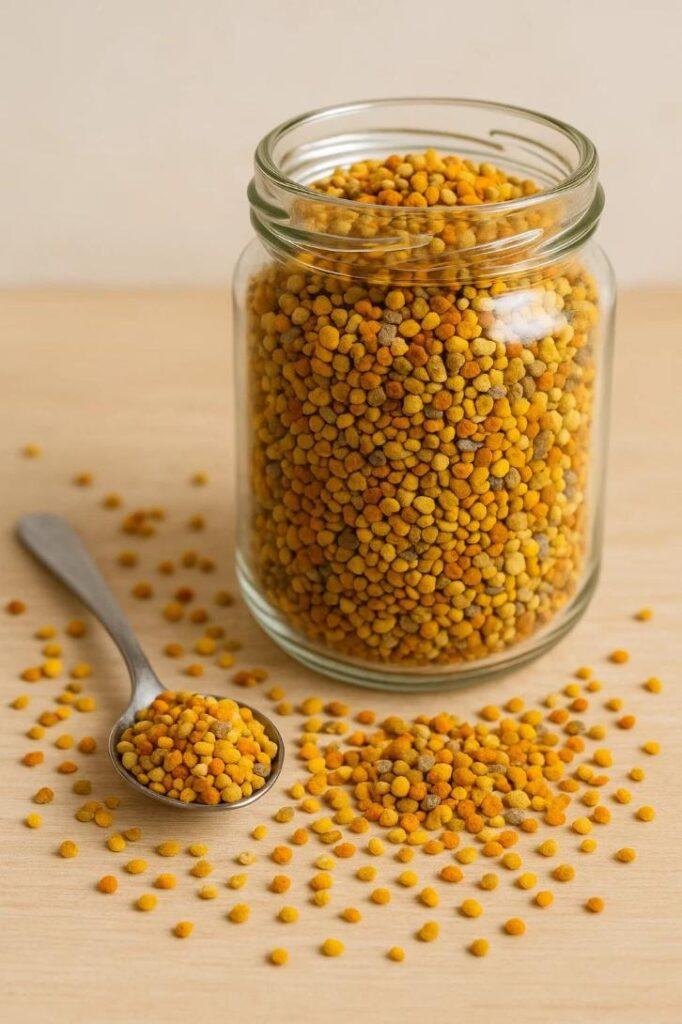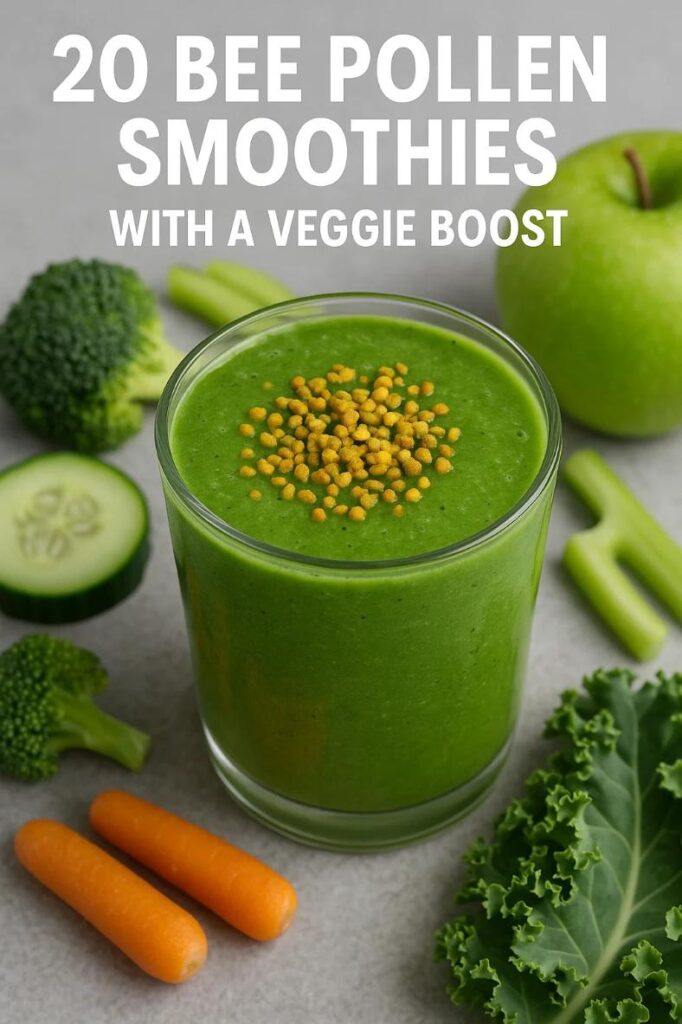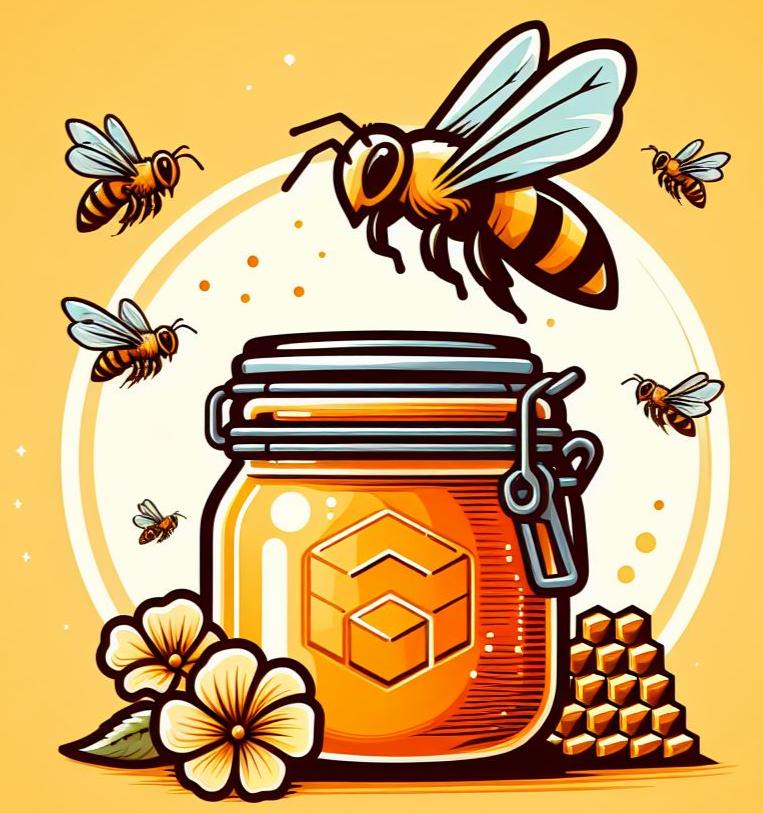Bee pollen’s been having its moment in the sun lately, and for a good reason. This buzzing superfood is more than just another trendy ingredient; it’s a delicate balance of proteins, vitamins, minerals, and enzymes that could just give your health an extra boost. If you haven’t considered adding it to your diet yet, maybe it’s time to let curiosity take the wheel, and an easy way to do it is to make bee pollen smoothies.
Also known as nature’s multivitamin, bee pollen is naturally packed with an impressive range of nutrients.
Tiny granules of bee pollen are a blend of plant pollen, nectar, enzymes, honey, and beeswax. It is like a treasure chest, brimming with proteins, amino acids, vitamins, minerals, and beneficial fats. All these good things come together to make bee pollen an excellent addition to punch up your diet.
Imagine grabbing a spoonful that’s got everything from energy-supporting carbs to immune-boosting antioxidants. Plus, the idea of sprucing up your meals with something directly sourced from vibrant nature, via our little honey bee friends, makes it even more fascinating.

If you are getting excited about the potential health perks of adding a bit of bee pollen in your meals, like better energy levels, a stronger immune system, or just spicing up your daily smoothie, then please read on. Also like with all things, you’ll want to know the ins and outs before diving in. Let’s explore, learn, and see where this tiny but mighty powerhouse fits into your life.
It is worth mentioning that some people mistake it for honey or propolis, but bee pollen is its own deal. Unlike honey, which is sweet and gooey, bee pollen is more neutral and powdery, often praised for its subtle yet distinctive taste.
Bee Pollen Smoothies: A Perfect Match
Bee pollen pairs effortlessly with a bunch of ingredients you probably already love, like fruits, greens, nuts, and of course honey. It brings a subtle, earthy sweetness that can round off flavours beautifully in any smoothie. Plus, it’s a great way to add some extra nutritional oomph without overpowering your favourite blends.
Beyond just tasting good, bee pollen smoothies may also bring some health perks. It’s like turbo-charging your drink with antioxidants and essential nutrients that work in sync to make you feel energised and ready to take on the day. That is why it is generally recommended to consume bee pollen in the first half of the day.
Spicing up your routine with bee pollen not only makes your smoothies richer in vitamins and minerals, but it also makes you feel like you’re sipping on something a little more special.
Health Benefits of Bee Pollen Smoothies
# Swirling bee pollen into your smoothie isn’t just about adding flair; it’s really about potential health benefits. This golden dust is loaded with antioxidants, which are known for their knack of fighting off free radicals. Free radicals are those pesky molecules that can muck up cells and lead to all kinds of nasties, so having bee pollen’s antioxidants on your side is a win.
# Bee pollen is also known for its vitamin richness, packing a punch from Vitamin C to Vitamin B complex, all promoting a better immune system. Staying on top of immunity wasn’t just a thing during flu season—it’s kind of always been important. A smoothie fortified with bee pollen might be what you need to keep your defenses up.
# Looking for a natural way to spike up the energy levels? The carbs, proteins, and amino acids in bee pollen can be your answer. It’s like nature’s very own pick-me-up tonic, offering sustainable energy so you’re ready to tackle whatever the day throws at you. Rather than hitting up that afternoon caffeine fix, maybe bee pollen smoothies should be your new go-to.
# If you’re watching your diet and looking to maintain or lose weight, there’s a little something for you too. Bee pollen might help with metabolism. That’s because some studies suggest it can support metabolic transformation.
Choosing the Right Bee Pollen: Types and Sources
When it comes to picking out bee pollen, not all options are created equal. Different types of bee pollen vary widely in terms of colour, size, and nutritional value, all depending on the plants visited by the bees. You might find darker granules or lighter ones, each hinting at different botanical origins.
Grabbing the right bee pollen is kind of like finding the perfect avocado — there’s a bit of art and science to it. Look for granules that feel dry but firm, avoiding anything that seems overly crumbly or moist, which can suggest it’s past its prime or improperly stored.
High-quality bee pollen should come with a strong, floral aroma without any off or fermented smells. This kind of freshness is key because you want those nutrients undiminished and ready to give your smoothie the boost it’s meant to.
Considering the sourcing of bee pollen is just as important. Going for products harvested from clean, pesticide-free environments is a must. Think local suppliers whenever possible, as they often ensure a fresher product and support ecological balance within your region.
I can’t ignore ethical sourcing either. Bees play a mega role in our ecosystems, and sustainable harvesting respects these little workers by not disrupting their natural cycles. Look for brands that highlight their bee-friendly practices, giving back to the environment while delivering the good stuff to you.
🕰️ Shelf Life of Bee Pollen
- Fresh (refrigerated or frozen): up to 1 year if kept in airtight containers in the freezer.
- Dried (dehydrated): typically 6 months to 1 year at room temperature, but up to 2 years if stored in a cool, dark, dry place, and airtight.
🧊 How to Store Bee Pollen
Freezer: best for long-term storage — preserves enzymes, vitamins, and active compounds.
Fridge: good for short-term use (within 1–2 months).
Pantry: acceptable if it’s a dry, dark, cool area — ideally below 20°C (68°F) — and used within a few months.
Airtight containers: always store in airtight jars or pouches to avoid moisture and oxidation.
✅ How to Know Bee Pollen is Fresh
Colour
Should be vibrant—yellow, orange, purple, green. Faded or dull colours indicate age or poor storage.
Smell
Should have a floral, earthy aroma. Musty or sour odours suggest spoilage.
Texture
Slightly soft or chewy when fresh or recently defrosted; dry or hard when fully dehydrated. Clumping is fine if it softens when crumbled.
Taste
Sweet, slightly bitter, floral. A stale or bland taste may indicate it’s losing potency.
How to Incorporate Bee Pollen into Smoothies
Incorporating bee pollen into your smoothie is straightforward, but a few tips can help you make the most of it. First off, start small. When you’re incorporating new ingredients into your diet, going easy on the dosage is key. A teaspoon might be a good start to see how your body reacts.
You don’t really want to load up on too much at once, especially if you’re trying it for the first time. Listen to your body and adjust the amount gradually to a tablespoon as it suits you. This helps avoid any unexpected reactions and lets you enjoy the benefits safely.
When it comes to adding bee pollen to your smoothies, all you’ve really got to remember is to sprinkle it in during the blending process. This helps it blend evenly, giving you a nice, smooth texture. If you like a bit of crunch, save a pinch to sprinkle on top after blending.
The beauty of smoothies is their versatility. Don’t hesitate to experiment. Try adding bee pollen with different base liquids like almond milk or coconut water for taste and nutrition that’s to your liking. Being adventurous with it ensures you always look forward to your next glass.
Bee Pollen Smoothies – 20 Delicious Recipes
If you’re looking for a tasty way to fuel your body, balance your mood, and boost immunity — all while sneaking in more vegetables — these bee pollen smoothie recipes are your new go-to.

Unlike typical fruit-heavy blends, these smoothies are thoughtfully crafted with a 70/30 ratio of vegetables to fruit, making them perfect for anyone aiming to reduce sugar intake while still enjoying vibrant, flavourful drinks.
Whether you’re in need of a morning energy lift, a gentle detox, or a mood-balancing afternoon treat, there’s a smoothie here to support your goals. Each recipe includes dairy-free and diabetic-friendly alternatives, so you can blend confidently no matter your dietary needs.
🌿 1. Energy-Boosting Bee Pollen Smoothies
Tropical Energy Kick
Ingredients: ½ banana, ¼ cup pineapple, ¼ cup mango, 1 cup spinach, ¼ cup zucchini (fresh or very lightly steamed), 1 tsp bee pollen, 1 tbsp chia seeds, ½ cup coconut water, ice.
Notes: dairy-free, diabetic-friendly (reduce pineapple).
Cacao Power Protein
Ingredients: ½ banana, 1 cup cauliflower/or broccoli (fresh or very lightly steamed), 1 tbsp raw cacao, 1 scoop vegan protein, 1 tsp bee pollen, 1 tbsp sunflower seed butter, ¾ cup almond milk.
Notes: dairy-free, diabetic-friendly.
Green Energiser
Ingredients: ½ green apple, 1 cup kale, ½ cucumber, 1 stalk celery, 1 tsp bee pollen, ½ lemon (juiced), ½ avocado, ¾ cup water.
Notes: dairy-free, diabetic-friendly.
Berry Bee Fuel
Ingredients: ¼ cup berries, ½ banana, 1 cup spinach, ½ cup zucchini, 1 tbsp bee pollen, ½ cup coconut yogurt, 1 tbsp ground flaxseed, ½ cup oat milk.
Notes: dairy-free, diabetic-friendly (omit banana).
💪 2. Immunity-Boosting Bee Pollen Smoothies
Citrus Immune Blast
Ingredients: ¼ orange, ¼ cup pineapple, 1 cup carrot, ½ cucumber, 1 tsp bee pollen, ½ tsp turmeric, 1 tbsp honey, ¼ cup water.
Notes: dairy-free, diabetic-friendly (omit honey).
Golden Glow Smoothie
Ingredients: ¼ banana, ¾ cup cauliflower/or broccoli (fresh or very lightly steamed), ¼ cup carrots, 1 tsp bee pollen, ½ tsp ginger, 1 tsp turmeric, 1 tsp coconut oil, 1 cup oat milk.
Notes: dairy-free, diabetic-friendly.
Green Defender
Ingredients: ¼ green apple, 1 cup spinach, ½ avocado, ½ cucumber, 1 tsp bee pollen, 1 tbsp hemp seeds, ½ lemon, ¾ cup water.
Notes: dairy-free, diabetic-friendly.
Bee Berry Defender
Ingredients: ¼ cup blueberries, ¼ cup strawberries, 1 cup kale, ½ cup zucchini, 1 tsp bee pollen, 1 tbsp coconut yogurt, 1 tbsp honey, 1 cup coconut water.
Notes: dairy-free, diabetic-friendly (omit honey).
🧘♀️ 3. Hormone & Mood Balancing Bee Pollen Smoothies
Maca Bee Bliss
Ingredients: ¼ banana, 1 cup spinach, ½ cup cauliflower/or broccoli (fresh or very lightly steamed), 1 tsp maca, 1 tbsp bee pollen, 1 cup almond milk, 1 tbsp sunflower butter, dash of cinnamon.
Notes: dairy-free, diabetic-friendly.
Omega Mood Smoothie
Ingredients: ¼ banana, ½ avocado, 1 cup kale, 1 tbsp ground flaxseed, 1 tsp bee pollen, 1 tbsp cacao nibs, 1 cup oat milk.
Notes: dairy-free, diabetic-friendly.
Lavender Calm Bee
Ingredients: ¼ banana, 1 cup zucchini, ½ cup spinach, 1 tsp bee pollen, ½ tsp lavender, 1 tbsp almond butter, 1 cup oat milk.
Notes: dairy-free, diabetic-friendly.
Chia Vanilla Hormone Helper
Ingredients: ¼ cup berries, 1 cup spinach, ½ cup cauliflower/or broccoli (fresh or very lightly steamed), 1 tbsp chia, 1 tsp bee pollen, 1 tsp vanilla, 1 tbsp maple syrup (opt), ¾ cup almond milk.
Notes: dairy-free, diabetic-friendly (omit syrup).
🦠 4. Detox & Gut Health Bee Pollen Smoothies
Detox Greens & Bee
Ingredients: ¼ green apple, 1 cup kale, ½ cucumber, 1 celery stick, 1 tbsp bee pollen, ½ lemon, 1 tbsp parsley, 1 cup water.
Notes: dairy-free, diabetic-friendly.
Aloe Bee Cleanse
Ingredients: ¼ banana, ½ cup pineapple, ¼ cup aloe gel, ½ cucumber, 1 cup spinach, 1 tsp bee pollen, 1 tbsp chia, 1 cup coconut water.
Notes: dairy-free, diabetic-friendly (omit banana).
Minty Gut Soother
Ingredients: ¼ green apple, 1 tbsp mint, ½ cucumber, 1 cup spinach, 1 celery stick, 1 tsp bee pollen, 1 cup dairy-free yogurt.
Notes: dairy-free, diabetic-friendly.
Charcoal Lemon Bee
Ingredients: ¼ banana, 1 cup cauliflower/or broccoli (fresh or very lightly steamed), ½ tsp activated charcoal, 1 tsp bee pollen, 1 tbsp lemon juice, 1 cup almond milk.
Notes: dairy-free, diabetic-friendly.
🌸 5. Skin & Beauty Smoothies
Radiant Glow Smoothie
Ingredients: ¼ cup strawberries, ¼ banana, 1 cup spinach, ½ cup zucchini, 1 tsp bee pollen, 1 tbsp collagen, 1 tsp chia, ¾ cup coconut water.
Notes: dairy-free, diabetic-friendly.
Hydrating Cucumber Melon Bee
Ingredients: ¼ cup honeydew melon, ¼ cucumber, 1 cup spinach, ½ avocado, 1 tsp bee pollen, mint, ½ lime, ¾ cup coconut water.
Notes: dairy-free, diabetic-friendly.
Antioxidant Beauty Bowl
Ingredients: ¼ cup blueberries, ¼ cup acai, 1 cup kale, ½ cup cauliflower/or broccoli (fresh or very lightly steamed), 1 tsp bee pollen, 1 tbsp hemp, ½ banana, ½ cup almond milk.
Notes: dairy-free, diabetic-friendly.
Brain & Beauty Boost
Ingredients: ¼ avocado, 1 cup spinach, ½ zucchini, 1 tsp bee pollen, 1 tbsp ground flaxseed, 1 tsp matcha, 1 tbsp sunflower butter, 1 cup oat milk.
Notes: dairy-free, diabetic-friendly.
Blend, sip, and enjoy your way to vibrant health with these colorful and nourishing bee pollen smoothies!
Potential Side Effects and Considerations
While bee pollen is generally safe for most people, it’s important to be aware of potential side effects and ensure it’s right for your body.
Allergies are the main concern here. If you know you have allergies to bee stings, honey, or pollen, it’s wise to proceed with caution. Start with a very small amount initially and watch for any adverse reactions like itching, swelling, or shortness of breath.
Another consideration is consulting a healthcare professional, especially if you have existing health conditions or are pregnant or breastfeeding. They can provide advice based on your personal health profile, which is crucial when introducing any new supplement to your diet.
People who are allergic to any pollen might experience an intense reaction even with a tiny amount. That’s why testing a small quantity first can be very wise.
If you’re taking medication, check with a healthcare provider to rule out any interactions. Bee pollen can affect some medications, as it may alter how your body processes them.
It’s also good to be aware that bee pollen isn’t a substitute for a varied and balanced diet. It’s a supplemental boost, not a miracle cure.
Respecting your body’s responses and staying informed are key steps in using bee pollen safely. Any signs of an allergic reaction should be taken seriously, and it’s vital to seek medical attention immediately if they occur.
Keeping these considerations in mind ensures your experience with bee pollen remains positive and beneficial.
Expert Tips and Final Thoughts
Nutritionists often emphasise starting small to gauge how your body responds before diving headfirst into this superfood.
If you’re feeling adventurous, mix bee pollen not just in smoothies but also in yogurt bowls or sprinkle it over salads for added crunch and nutrition.
Dietitians suggest keeping an open mind to experimenting with different flavours and combinations. Each person’s palate and nutritional requirements are unique, so listen to your body and taste preferences.
It’s about consistency too. Making bee pollen a regular part of your diet, if it sits well with your body, can help you steadily reap its potential health benefits.
Don’t stop with just bee pollen smoothies — explore other superfoods like chia seeds or spirulina. These can complement the pollen and make your smoothies even more nutrient-packed.
Beyond just the health angle, enjoy the process of crafting smoothie blends that are both delicious and healthful. Your taste buds and body will thank you.
Remember, it’s all about enjoying the journey of better health, one tasty sip at a time. Stick with what works for you, and let the adventure continue beyond this one ingredient.
